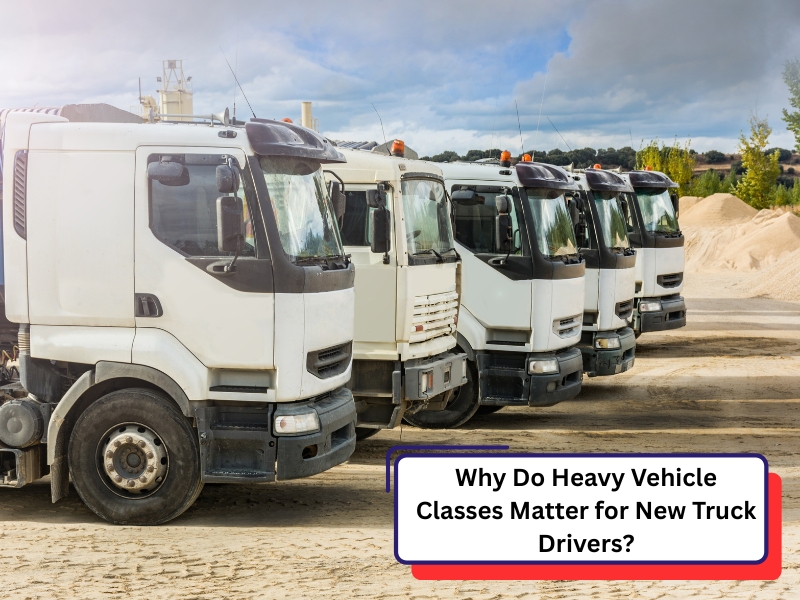Starting your journey in the transport industry can be both exciting and daunting. One of the most common hurdles for new truck drivers is understanding heavy vehicle classes. These classes aren’t just random labels—they impact everything from the type of trucks you can drive to the jobs you’ll be eligible for. It’s easy to feel overwhelmed with many codes and licence types, especially when each state might have slight variations. But getting this part wrong could cost you time, money, and career opportunities. This article helps you untangle the confusion so you can move forward with confidence.
What confuses new drivers about heavy vehicle classes?
New drivers often stumble immediately by misreading or misunderstanding heavy vehicle class definitions. This confusion usually comes from two main areas: inconsistent information and misleading advice from peers or online forums.
- Overlapping licence codes, such as LR (Light Rigid) and MR (Medium Rigid), can sound too similar.
- Advice from unverified sources, like mates or online chat groups, can steer you in the wrong direction.
- There are no clear examples of what each licence class covers in real-world driving.
- Assuming upgrades are automatic, when they often require structured testing and training.
Understanding licence classes at the beginning can be as challenging as learning a new language. In addition to licence categories, safety technologies like ADAS windscreen calibration play a vital role in ensuring driver awareness and vehicle control, especially when managing heavy loads or navigating challenging road conditions.
What happens if you choose the wrong licence class?
Choosing the incorrect licence class can lead to more than just paperwork headaches. It can impact your employment chances and put your future in the industry on hold.
- Delayed job applications because you need to reschedule for the correct training.
- Wasted money on licence courses that don’t suit your career path.
- Failed assessments due to a mismatch between the training and your driving goals.
- Increased frustration, may lead some drivers to abandon the process altogether.
Understanding which class is right for your goals from the beginning saves you time and resources. Not sure where to begin? A significant first step is to explore the benefits of upgrading your truck licence in Sydney to help align your learning with where you want to end up.
Can a misunderstanding of heavy vehicle classes delay your licence?
Absolutely. Misunderstanding how licence classes are structured can push back your progress for months. Unfortunately, this issue crops up often because drivers assume that holding a car licence means an easy jump into heavy vehicles.
- Rebooking delays due to enrolling in the wrong class.

- Documentation issues, especially if you can’t meet the prerequisites for certain levels.
- Mandatory waiting periods increase every time you switch or restart your training path.
- Miscommunication with RTOs leads to further setbacks.
Even if you’re confident behind the wheel, incorrect paperwork or licence classification can halt your momentum. To clarify this, it helps to understand what requirements are needed for a truck licence before diving into formal lessons.
How can training help clarify different classes?
Structured training with accredited providers is your best bet for understanding heavy vehicle classes. Unlike internet threads or casual advice, professional trainers offer real-world context and scenarios you’ll likely face on the job.
- Practical driving sessions tailored to your chosen vehicle class.
- Up-to-date info on legal changes and state-specific variations.
- Step-by-step breakdowns of what each licence allows you to drive.
- Immediate feedback builds confidence and speeds up learning.
The goal is not just passing a test but ensuring you’re prepared to hit the road safely. For new drivers looking to build a career, it’s crucial to find the proper training for your desired heavy vehicle classes early on.
Which heavy vehicle classes offer the most career options?
When it comes to future job flexibility, not all licence classes are created equal. Some offer more versatility and open doors across multiple industries.
Licence Class | Description | Typical Vehicles | Common Career Roles |
LR (Light Rigid) | Vehicles up to 8 tonnes GVM, with a single axle | Small trucks, minibuses | Local deliveries, community transport |
MR (Medium Rigid) | Vehicles over 8 tonnes GVM, 2 axles | Medium trucks, school buses | Urban freight, council services |
HR (Heavy Rigid) | Vehicles over 8 tonnes GVM, 3+ axles | Waste trucks, large rigid trucks | Waste management, local freight |
HC (Heavy Combination) | One trailer (not a B-double) | Semi-trailers, tanker trucks | Long-distance haulage, fuel delivery |
MC (Multi Combination) | B-doubles and road trains | Very large freight vehicles | Interstate logistics, mining transport |
If you want a broader comparison across all licence levels, you can check an overview of heavy vehicle licence classes and requirements to get a better sense of what each offers.
How do heavy vehicle classes influence licence test preparation?
Your chosen vehicle class directly impacts what you’ll face during the driving test. Test preparation isn’t one-size-fits-all, and skipping this detail can cost you a pass.
- Different test routes depending on vehicle size and braking systems.
- Varied assessment criteria, such as air brake handling and reversing angles.
- Vehicle-specific manoeuvres, which increase in difficulty with each higher class.
- Greater examiner expectations, especially for higher-risk vehicle types.
Whether you’re going for an HR or MC licence, your success depends on preparing for that specific test structure. Tailored training will ensure you’re not caught off-guard by vehicle-specific challenges or new road rules.

Why should new drivers understand heavy vehicle classes early?
Getting a grip on licence classes early in your driving journey saves headaches later on. It’s not just about passing a test—it’s about shaping your entire career.
- Informed decisions, so you’re not switching courses halfway through.
- Faster job placement, since you already hold the right qualifications.
- Confidence in skills, knowing you’re trained for the exact vehicles you’ll drive.
- Better financial planning, with fewer surprises and backtracking.
There’s no benefit in winging it. A solid understanding from the get-go lays the groundwork for a smooth and successful entry into truck driving.
Final Thoughts
Whether you’re aiming for a steady HR job or working toward the flexibility of an MC licence, understanding heavy vehicle classes is essential. Missteps in the beginning can lead to wasted time and money, but with the proper guidance, they’re avoidable.
If you have questions or you’re unsure which licence suits your long-term goals, it’s a smart move to reach out to the team at Core Truck Driving School for more guidance.


